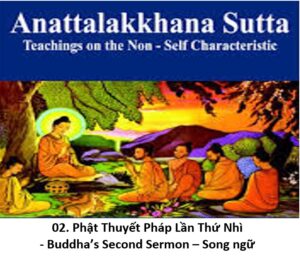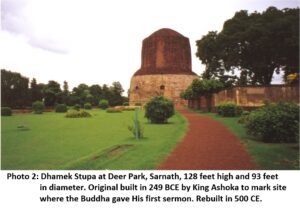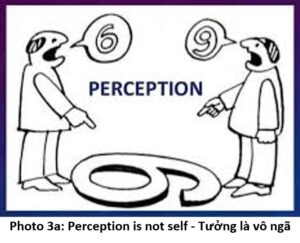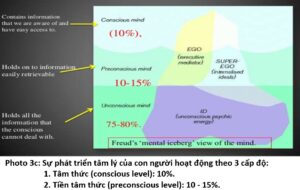Phật Thuyết Pháp Lần Thứ Nhì – Buddha’s Second Sermon – Song ngữ
English: Thanissaro Bhikkhu.
Việt ngữ: HT Thích Minh Châu – 08-11-2006.
Compile: Middle Way Group.

Intro – Giới thiệu
On the fifth day after he arrived at the Deer Park at Isipitana near Benares where he delivered his first sermon to the five wandering monks and converted them to his path, the Buddha delivered them his second discourse called Anatta-lakkhana Sutta (The Not-Self characteristic). At the end of this discourse all five disciples became arahants. Some months later the Buddha preached the third sermon called Ādittapariyāya Sutta (Fire Sermon).
Vào ngày thứ năm sau khi Ngài đến Vườn Lộc Uyển ở Isipitana gần Benares, nơi Ngài thuyết pháp đầu tiên cho năm nhà sư lang thang và cải họ theo con đường của Ngài, Đức Phật thuyết cho họ bài kinh thứ hai gọi là Anatta-lakkhana Sutta (Vô Ngã Tướng). Vào cuối bài kinh này, cả năm đệ tử đều trở thành A la hán. Vài tháng sau, Đức Phật thuyết giảng bài pháp thứ ba gọi là Ādittapariyāya Sutta (Bài giảng về lửa).

2. Buddha’s Second Sermon: Vô Ngã Tướng – Not-Self Characteristic
I have heard that:
-On one occasion the Blessed One was staying at Varanasi in the Game Refuge at Isipatana. There he addressed the group of five monks:
-“Monks”
-” Yes, Lord”. The monks responded to Blessed One.
There the Blessed One said:
Tôi nghe như vầy: Một thời Thế Tôn ở Bàrànasi (Ba-la-nại), tại Isìpatana (Chư Tiên đọa xứ), vườn Lộc Uyển. Ở đây Thế Tôn nói với đoàn năm vị Tỷ-kheo:
-“Này các Tỷ-kheo”.
– “Thưa vâng bạch Thế Tôn”. Các Tỷ-kheo ấy vâng đáp Thế Tôn.
Thế Tôn nói như sau:

“Form, monks, is not self. If form were the self, this form would not lend itself to disease. It would be possible [to say] with regard to form, ‘Let this form be thus. Let this form not be thus.’
But precisely because form is not self, form lends itself to disease. And it is not possible [to say] with regard to form, ‘Let this form be thus. Let this form not be thus.’
Sắc, này các Tỷ-kheo, là vô ngã. Này các Tỷ-kheo, nếu sắc là ngã, thời sắc không thể đi đến bệnh hoạn và có thể được các sắc như sau: “Mong rằng sắc của tôi là như thế này! Mong rằng sắc của tôi chẳng phải như thế này!”
Và này các Tỷ-kheo, vì sắc là vô ngã. Do vậy sắc đi đến bệnh hoạn, và không thể có được các sắc: “Mong rằng sắc của tôi như thế này! Mong rằng sắc của tôi chẳng phải như thế này!”

-“Feeling is not self…
-“Perception is not self…
-“[Mental] fabrications are not self…
-Thọ, này các Tỷ-kheo, là vô ngã…
-Tưởng là vô ngã, …
-Các hành là vô ngã, …
“Consciousness is not self. If consciousness were the self, this consciousness would not lend itself to disease. It would be possible [to say] with regard to consciousness, ‘Let my consciousness be thus. Let my consciousness not be thus.’
But precisely because consciousness is not self, consciousness lends itself to disease. And it is not possible [to say] with regard to consciousness, ‘Let my consciousness be thus. Let my consciousness not be thus.’
Thức là vô ngã, này các Tỷ-kheo, nếu thức là ngã, thời thức không thể đi đến bệnh hoạn, và có thể có được thức như sau: “Mong rằng thức của tôi như thế này! Mong rằng thức của tôi chẳng phải như thế này!”
Và này các Tỷ-kheo, vì thức là vô ngã. Do vậy, thức đi đến bệnh hoạn, và không có thể có được thức: “Mong rằng thức của tôi như thế này! Mong rằng thức của tôi chẳng phải như thế này!”
-What do you think, monks: Is form constant or inconstant?”
-Inconstant, lord.”
-And is that which is inconstant easeful or stressful?”
-Stressful, lord.”
-And is it proper to regard what is inconstant, stressful, subject to change as: ‘This is mine. This is my self. This is what I am’?”
-No, lord.”
Các ông nghĩ thế nào, này các Tỷ kheo, sắc là thường hay vô thường?
– Là vô thường, bạch Thế Tôn.
– Cái gì vô thường là khổ hay lạc?
– Là khổ, bạch Thế Tôn.
– Cái gì vô thường, khổ, chịu sự biến hoại, có hợp lý chăng khi quán cái ấy là: “Cái này là của tôi. Cái này là tôi. Cái này là tự ngã của tôi”?
– Thưa không, bạch Thế Tôn.

-Is feeling constant or inconstant?”
-Inconstant, lord.”…
-Is perception constant or inconstant?”
-Inconstant, lord.”…
-Are fabrications constant or inconstant?”
-Inconstant, lord.”…
– “Thọ là thường hay vô thường?”
– “Là vô thường, bạch Thế Tôn.”
-” Tưởng là thường hay vô thường?”
– “Là vô thường, bạch Thế Tôn.”
– “Hành là thường hay vô thường?”
– “Là vô thường, bạch Thế Tôn.”
-Is consciousness constant or inconstant?
-Inconstant, lord.”
-And is that which is inconstant easeful or stressful?”
-Stressful, lord.”
-And is it proper to regard what is inconstant, stressful, subject to change as: ‘This is mine. This is my self. This is what I am’?”
-“No, lord.”
-“Thức là thường hay vô thường?”
– “Là vô thường, bạch Thế Tôn.”
– “Cái gì vô thường là khổ hay lạc?”
– “Là khổ, bạch Thế Tôn.”
– “Cái gì vô thường, khổ, chịu sự biến hoại, có hợp lý chăng khi quán cái ấy là: “Cái này là của tôi. Cái này là tôi. Cái này là tự ngã của tôi”?
– “Thưa không, bạch Thế Tôn.”
“Thus, monks, anybody whatsoever that is past, future, or present; internal or external; blatant or subtle; common or sublime; far or near: everybody is to be seen as it actually is with right discernment as: ‘This is not mine. This is not myself. This is not what I am.’
Do vậy, này các Tỷ kheo, phàm có thân gì thuộc quá khứ, vị lai, hoặc hiện tại; hoặc liệt hay thắng; hoặc nội hay ngoại; hoặc thô hay tế; xa hay gần: Phàm thức phải được thấy như chơn: ” Không phải là ta, không phải của ta, không phải tự ngã của ta.”
-Any feeling whatsoever…
-Any perception whatsoever…
-Any fabrications whatsoever…
-Phàm xúc nào, ….
-Phàm tưởng nào, ….
-Phàm các hành ….

3. Tiềm thức, vô thức (subconscious, unconscious level): 75 – 80%
“Any consciousness whatsoever that is past, future, or present; internal or external; blatant or subtle; common or sublime; far or near: every consciousness is to be seen as it actually is with right discernment as: ‘This is not mine. This is not myself. This is not what I am.’
Phàm có thức gì thuộc quá khứ, vị lai, hoặc hiện tại; hoặc liệt hay thắng; hoặc nội hay ngoại; hoặc thô hay tế; xa hay gần: Phàm thức phải được thấy như chơn: ” Không phải là ta, không phải của ta, không phải tự ngã của ta.”
“Seeing thus, the well-instructed disciple of the noble ones grows disenchanted with the body, disenchanted with feeling, disenchanted with perception, disenchanted with fabrications, disenchanted with consciousness. Disenchanted, he becomes dispassionate. Through dispassion, he is fully released. With full release, there is the knowledge, ‘Fully released.’ He discerns that ‘Birth is ended, the holy life fulfilled, the task done. There is nothing further for this world
Do thấy vậy, vị Đa văn Thánh đệ tử yếm ly thân, yếm ly xúc, yếm ly tưởng, yếm ly các hành, yếm ly thức. Do yếm ly, vị ấy ly tham. Do ly tham, vị ấy giải thoát. Trong sự giải thoát là sự hiểu biết: “Ta đã được giải thoát “. Và vị ấy biết: “Sanh đã tận, Phạm hạnh đã thành, các việc nên làm đã làm, không còn trở lui trạng thái này nữa”.

That is what the Blessed One said. Gratified, the group of five monks delighted at his words. And while this explanation was being given, the hearts of the group of five monks, though not clinging (not being sustained), were fully released from fermentation/effluents.
Thế Tôn thuyết như vậy. Nhóm năm vị Tỷ-kheo hoan hỷ, tín thọ lời Thế Tôn dạy. Trong khi lời dạy này được nói lên, tâm của nhóm năm vị Tỷ-kheo được giải thoát khỏi các lậu hoặc, không có chấp thủ.

Sources:
Tài liệu tham khảo:
- http://www.phapluan.net/DieuPhap/access_to_insight/TUONG_UNGBO/Anatta-lakkhana Sutta_SN_22_59.htm
- https://www.hinduwebsite.com/buddhism/anatta.asp
- http://chinabuddhismencyclopedia.com/en/index.php/The_Second_Sermon_of_the_Buddha
- Photo 1: https://www.vipassana.com/resources/box/djv-anattalakkhana-vf10.pdf
- Photo 2: http://xuanfa.net/buddha-dharma/tripitaka/suttas-sutras/anatta-lakkhana-sutta/
- Photo 3: http://evdhamma.org/index.php/dharma/dharma-lessons/item/165-05-ngu-uan-song-ngu
- Photo 3a: https://www.psychologytoday.com/us/blog/the-power-prime/201908/perception-is-not-reality
- Photo 3b: http://evdhamma.org/index.php/dharma/dharma-lessons/item/1074-tam-phap-an-song-ngu
- Photo 3c: http://evdhamma.org/index.php/documents/collections/body-and-mind/item/58-tam-thuc-consciousnesses-song-ngu
- Photo 4: http://evdhamma.org/index.php/dharma/dharma-lessons/item/1075-niet-ban-phat-giao-song-ngu
- Photo 5: http://evdhamma.org/index.php/dharma/dharma-lessons/item/1075-niet-ban-phat-giao-song-ngu
